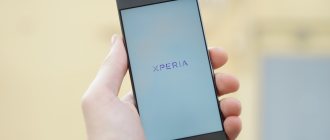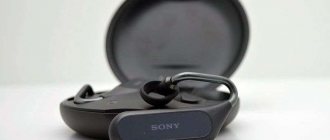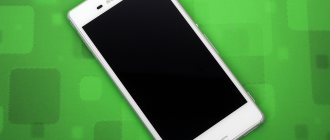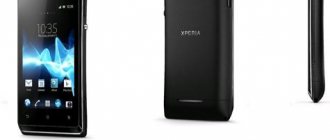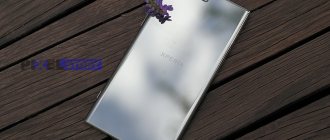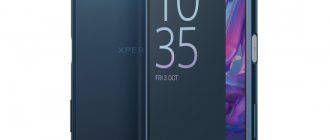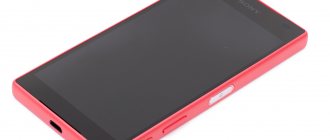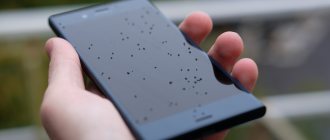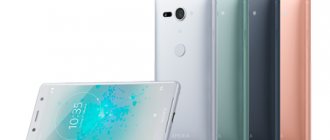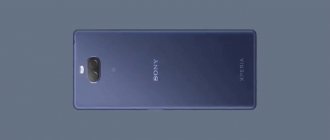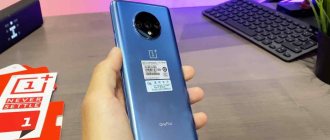Design
It’s worth saying right away that I like Sony’s strict design and even liked their new design concept presented in the new Xperia XZ2 series. Of course, I would like to criticize Sony for the wide frames at the top and bottom, but all this is due to the size of the front camera modules.
The Xperia XA2 Ultra has a matte plastic body, but it feels metallic, the sides are made of aluminum, and the top and bottom edges are polished. Whether in photographs or in real life, the phone looks spectacular.
But even though the Xperia XA2 Ultra looks expensive, it's poorly made. In this case, we can’t even say that this is a special case, since Sony is negligent when it comes to budget smartphones and you definitely shouldn’t expect super quality from them.
It’s also unclear why Sony still uses the OmniBalance-style lock button, since flagships use a different button shape. In addition, the fingerprint sensor on the back is located quite high, which makes it not always convenient to use.
Ergonomics.
When buying an Xperia XA2 Ultra, a person should be aware that this is a 6-inch device and there can be no talk of convenient use.
It’s impossible to use the phone with one hand, and even if you really want to, you won’t be able to. Branded tricks to reduce the elements on the screen, which in theory should allow you to use the smartphone with one hand, do not help from this.
During almost all the time I used it, I couldn't put the phone in my trouser pockets properly, so you'll have to think in advance where you'll be carrying the phone. Also, the situation is aggravated by sharp edges, they dig into the hand, which makes it even uncomfortable to put it in a jacket pocket.
In general, I would like to say that the Xperia XA2 Ultra is an inconvenient device, but on the other hand, it is a phablet and you definitely shouldn’t expect anything else. And the fact that the smartphone is easily soiled is also not so critical, since prints are erased very easily.
The vibration motor leaves much to be desired, it is as ordinary as on any other phones.
Screen
The Xperia XA2 Ultra has a 6-inch IPS screen with FHD resolution and a pixel density of 367 ppi. There are almost no questions about the quality of the display. Brightness and contrast are on par with the previous generation of the XA series, but there are no significant changes.
Whatever one may say, the matrix resolution and color reproduction are more than enough to watch video content. Reading books in the dark, compared to its competitors, is inconvenient on it, since there is still no comfortable viewing mode.
The user can also configure the display of colors in the RGB space, which will allow for more pleasant color rendering, but at the same time the screen will become less bright.
You can enable color enhancements or extreme brightness mode. These functions change almost nothing in everyday use, but at the same time they radically change the contrast of videos and photos in the proprietary Album application.
The matrix has two significant drawbacks. The first is the small brightness range; while it can still be used in the dark, in sunny weather the screen becomes too dim. The next problem is the display of colors. At angles, colors lose saturation.
Display
The matrix of the Sony Xperia XA2 Ultra smartphone is represented by a 6-inch screen using IPS technology. There is a feeling that it has migrated from the smartphone of last year. Those who had a chance to deal with it or read reviews remember that the quality of the screen was excellent.
- Bright, beautiful display with excellent readability at night and during the day.
- Automatic brightness adjustment works accurately and without any user intervention.
- Considering the diagonal of the smartphone, a resolution of 1920*1080 pixels is enough, and 4K, which some users dream of, is not really needed here.
- A wide viewing angle without inverting colors allows you to watch movies or videos on the device with a whole group. Everyone will be comfortable and clearly visible.
Software
Like most devices in 2020, the Xperia XA2 Ultra runs Android 8.0 Oreo with the March Android security patch. The Xperia UI shell has minimal differences from stock Android.
There is almost nothing to talk about the shell; if you are interested in learning more about all the possibilities, you can read our review.
Of the majority of the functions in the review, I would like to highlight Xperia Assist - this application gives various tips, with the help of which you can flexibly configure the device while moving on the street or during gameplay.
As expected, Android 8.0 works great, with almost no glitches or freezes. By and large, there is almost everything you need in 2018, the only thing missing is a night mode.
The sad thing is that the Xperia UI shell is degrading more and more every year. The normal STAMINA mode has already been taken away from us, miniature applications have been removed, which were much more convenient than split screen.
At the moment, Xperia UI is entering its final phase of existence. Sony announced the end of support for the Weather application, a few months earlier they “killed” TrackID, they will then stop supporting other branded applications, and so on.
In the end, Sony will still switch to bare Android and the famous SonyStyle will finally sink into oblivion.
Sony Xperia XA2 – a good replacement
I’ll probably start with this smartphone, since it’s most interesting to me in terms of weight and size parameters. I don’t like phablets, sorry J. Compared to its predecessor Xperia XA1, the newcomer has taken a step forward. With smaller dimensions, the Xperia XA2 has a 5.2-inch diagonal screen and it is a Full HD matrix, covered with Gorilla Glass with noticeable rounding on the sides (soon we will make a quick comparison of both smartphones). The dimensions of the smartphone are 142 x 70 x 9.7 mm and it weighs 171 grams. Side frame made of anodized aluminum with chamfers along the contour of the bottom and top edges.
It was also pleasant to use a solution from Qulcomm as a chipset - this is a Snapdragon 630 with a 64-bit processor with 8 cores and Adreno 510 video. 3 GB of RAM, 32 GB of internal memory with a microSD slot. I was pleased to see the battery increase to 3300 mAh (the predecessor had 2300 mAh) - it should last quite well. Out of the box, the smartphone comes pre-installed with Android 8.0 Oreo.
In terms of photography, we have a 23-megapixel module with an 84-degree wide lens and f2.0 aperture, hybrid autofocus. The camera can record 4K video, FullHD at 60 FPS, as well as slow motion 120 frames per second. The front camera is 8 megapixels with a 120-degree ultra-wide-angle lens and f2.4 aperture; there is no optical stabilizer. It's a pity that the front camera wasn't equipped with a flash.
Among other things, there is a headphone jack, USB Tupe-C, NFC and Bluetooth 5.0.
Camera
The camera issue for Xperia smartphones is still a sore subject. Disputes about the quality of cameras, software, and so on continue to this day on the Internet. Some believe that Xperia cameras are the best on the market, while others believe that Sony is five years behind the competition.
Speaking about the Xperia XA2 Ultra, I would like to focus not on the main one, but on the two front cameras. The first 16 MP module with proprietary Exmor RS technology with f/2.0 aperture and optical image stabilization. The second camera is 8 MP Exmor R with a wide-angle range of 120° and f/2.4 aperture.
Both cameras shoot well during the day, plus or minus, the white balance is quite accurate, the colors are close to natural. True, a wide lens slightly distorts the picture, but there is no escape from this, because these limitations are due to the size of the module.
At night, the shooting quality drops, noise and artifacts appear, and sharpness decreases significantly. The automatic mode is not capable of producing a high-quality picture; it is better to use the manual mode.
Take a look at the test shots:
There is also a night portrait mode. The phone can theoretically take a portrait using the front flash, but in reality everything looks more than dull. You can catch a successful shot only 3-4 times.
The main camera has a 23 megapixel module with an f/2.0 aperture, phase detection autofocus and a bright flash. The automatic mode works quite poorly and does not reveal all the capabilities of the camera, I recommend trying manual settings.
Video quality is normal, colors are acceptable and sharpness is fine. There is support for shooting in Full HD HDR and 4K format. The sound quality is terrible, the camera did not overheat.
The camera app is, as always, terrible and has a huge number of shortcomings, for example, 4K shooting still runs in a separate mini-application.
As a result, the main and front cameras are normal, although the functionality of the two front eyes could have been made wider. In addition, Sony Mobile urgently needs to improve the software and use AI to improve images.
Review of Sony Xperia XA2 Ultra: tablet phone with two selfie cameras and good battery life
In the new year, Sony did not delay in showing its new mobile products and at the first CES exhibition of 2020 in Las Vegas, it presented the world with three updated models. They were Sony Xperia XA2 Ultra, Xperia XA2 and Xperia L2. As can be seen from the names, all of these mobile devices are successors of one or another line. Among the new products, the tablet phone from the popular Ultra series stands out: the device is not top-end, but has several features that can interest fans of devices that combine the capabilities of a phone and a tablet.
Main characteristics of Sony Xperia XA2 Ultra (model H4213)
- SoC SoC Qualcomm Snapdragon 630, 8 cores ARM Cortex-A53 @1.8/2.2 GHz
- GPU Adreno 508
- Operating system Android 8.0
- Touch display IPS 6″, 1920×1080, 403 ppi
- Random access memory (RAM) 4 GB, internal memory 32/64 GB
- Nano-SIM support (2 pcs.)
- MicroSD support up to 256 GB
- GSM/GPRS/EDGE networks (850/900/1800/1900 MHz)
- WCDMA/HSPA+ networks (850/900/1900/2100 MHz)
- Networks LTE Cat.12/13 FDD (B1/2/3/5/7/8/20), TD (B38)
- Wi-Fi 802.11a/b/g/n (2.4 and 5 GHz)
- Bluetooth 5.0
- NFC
- GPS, A-GPS, Glonass, BDS
- USB Type-C, USB OTG
- Main camera 23 MP, f/2.0, autofocus, 4K video
- Front camera 16 + 8 MP, autofocus, flash
- Proximity and lighting sensors, accelerometer, magnetometer
- Fingerprint's scanner
- Battery 3580 mAh, Quick Charge 3.0
- Dimensions 163×80×9.5 mm
- Weight 221 g
| Average price Sony Xperia XA2 Ultra (32 GB) | Average price Sony Xperia XA2 Ultra (64 GB) |
| find out prices | find out prices |
| Retail offers Sony Xperia XA2 Ultra (32GB) | Retail offers Sony Xperia XA2 Ultra (64GB) |
| find out the price | find out the price |
Appearance and ease of use
The Sony Xperia XA2 Ultra looks better in pictures than in real life. Up close, it looks rough, heavy, bulky; the sharp corners in terms of such huge dimensions and weight are not at all pleasing and make it difficult to comfortably carry the smartphone. If the previous model Sony Xperia XA1 Ultra was all so neat with a flat back wall, which made the body visually thinner and more elegant, here for some reason the back wall was made convex.
This immediately visually and tactilely enlarged the device, depriving it of its only possible trump card, since the overall dimensions of the smartphone are already quite large. In addition, the case, as before, is not all-metal, but stacked: the back cover is made of metal, the sides are made of plastic, the bottom and top panels are also metal. It's all put together with clearly visible seams, and the build here is somehow more striking than the first Sony Xperia XA1 Ultra.
The device is so different in quality from other products of the Japanese company that sometimes it seems as if we are looking at a Chinese counterfeit of a Sony smartphone. However, if you do not take into account the huge dimensions, then in general everything is not bad with ergonomics: the smartphone does not become covered with fingerprints and does not slip out of your hand.
The camera module on the back side hardly protrudes beyond the surface, but due to the curved back cover, the smartphone still sways when you touch the screen while lying on the table.
The fingerprint scanner here was installed not inside the power button, but on the back wall, like everyone else, which makes this smartphone even more different from other Sony mobile devices. There are no complaints about the operation of the fingerprint scanner itself; recognition occurs clearly.
The front panel is completely covered with protective glass, the manufacturer of which Sony has finally begun to announce that it is Gorilla Glass, but without specifying which generation. In previous years, she even hid the name of the manufacturer, so this is partly a breakthrough. An LED event indicator was installed above the screen, which is convenient.
There are no hardware buttons at the bottom below the screen; there are only on-screen buttons here. Their panel cannot be removed and called back with a wave; it is almost always present on the screen, although in some applications and games it still disappears.
As usual, there are more buttons on the sides than other manufacturers, since a separate camera control key has not been forgotten. In the absence of the ability to shoot underwater, there is no urgent need for a mechanical button for shooting, but some users still like its presence, although there are several redundant options for releasing the shutter.
The card slot is not hybrid; a memory card can be installed here in addition to two Nano-SIM format SIM cards in a separate slot. Whenever you manipulate the cover of this connector, the device automatically reboots.
At the top end, in addition to the second microphone, there is also a 3.5 mm audio output for headphones.
At the bottom end there is a not entirely symmetrical and not very elegant combination of a USB Type-C connector, a small speaker grille and a conversational microphone. Perhaps this is exactly the case when a second, fake grille would not hurt, since now the huge lower metal plate looks clearly empty.
Sony Xperia XA2 Ultra is available in four different colors: black, silver, blue and gold. Sony is one of the few companies whose front panel always matches the overall color of the body. The smartphone did not receive protection from dust and moisture.
Screen
Sony Xperia XA2 Ultra is equipped with an IPS display covered with 2.5D Gorilla Glass with slightly sloping edges. The physical dimensions of the screen are 75x133 mm with a diagonal of 6 inches. The display resolution is 1920x1080, the pixel density is about 367 ppi. At the same time, the lower black strip, a centimeter high, with virtual buttons is not removed from the screen in the standard interface - only in games and some other full-screen applications. The frame around the screen is amazing. There is practically no space on the sides: only due to the sides of the case, about 2 mm is gained to the overall width, but if you look at the glass, the frame does not extend even a millimeter. But the margins at the top and bottom are impressive: about 15 mm at the top and about 12 mm at the bottom.
It is possible to use automatic brightness adjustment based on the operation of the ambient light sensor. Multi-touch tests diagnose support for 10 simultaneous touches.
A detailed examination using measuring instruments was carried out by the editor of the “Monitors” and “Projectors and TV” sections Alexey Kudryavtsev
. Here is his expert opinion on the screen of the sample under study.
The front surface of the screen is made in the form of a glass plate with a mirror-smooth surface that is scratch-resistant. Judging by the reflection of objects, the anti-glare properties of the screen are better than those of the Google Nexus 7 (2013) screen (hereinafter simply Nexus 7). For clarity, here is a photograph in which a white surface is reflected in the switched off screens of both devices (Sony Xperia XA2 Ultra, as is easy to determine, is on the right; then they can be distinguished by size):
Both screens are dark, but the Sony screen is still darker (its brightness in the photo is 101 versus 108 for the Nexus 7). The tripling of reflected objects in the Sony Xperia XA2 Ultra screen is very weak, this indicates that there is no air gap between the outer glass (also known as the touch sensor) and the surface of the matrix (OGS - One Glass Solution type screen). Due to the smaller number of boundaries (glass/air type) with very different refractive indices, such screens look better under intense external illumination, but their repair in the case of cracked external glass is much more expensive, since the entire screen has to be replaced. The outer surface of the screen has a special oleophobic (grease-repellent) coating (very effective, even better than that of the Nexus 7), so fingerprints are removed much more easily and appear at a lower speed than with regular glass.
When manually controlling the brightness and displaying the white field in full screen, its maximum value was about 620 cd/m², and the minimum was 5.4 cd/m². The maximum value is very high, and, given the excellent anti-glare properties, in bright daylight and even in direct sun the image on the screen should be clearly visible. In complete darkness, the brightness can be reduced to a comfortable level. There is automatic brightness adjustment based on the light sensor (it is located to the right of the logo on the front panel). In automatic mode, as external lighting conditions change, the screen brightness both increases and decreases. The operation of this function depends on the brightness adjustment setting. If the brightness slider is set to maximum, then in complete darkness the auto-brightness function reduces the brightness to 110 cd/m² (bright), in an artificially lit office (about 400 lux) it sets it to 415 cd/m² (excessively bright), in a very bright environment (corresponds to lighting on a clear day outdoors, but without direct sunlight - 20,000 lux or a little more) increases to 620 cd/m² (to the maximum, which is what is needed). If the brightness slider is at half scale, then the screen brightness for the three conditions indicated above is as follows: 50, 300 and 620 cd/m² (in the office it could be lower). If the brightness control is set to minimum - 3, 180, 620 cd/m² (the first value is too low). We were more satisfied with the option with a slider of about 20%: 20, 130, 620 cd/m². As a result, the auto-brightness function works absolutely adequately, and it is possible to adjust the nature of the brightness change to the user’s requirements. At any brightness level, there is no significant backlight modulation, and therefore there is no screen flickering.
This screen uses an IPS type matrix. The microphotographs show a typical IPS subpixel structure:
For comparison, you can see the gallery of microphotographs of screens used in mobile technology.
The screen has good viewing angles without inverting shades and without significant color shifts, even with large viewing deviations from perpendicular to the screen. For comparison, here are photographs in which the same images are displayed on the screens of the Nexus 7 and Sony Xperia XA2 Ultra, while the brightness of the screens was initially set to approximately 200 cd/m² (across the white field in the entire screen), and the color balance on the camera was forcibly switched to 6500 TO.
White field perpendicular to the plane of the screens:
Note the good uniformity of brightness and color tone of the white field.
And a test picture:
The colors on the Sony Xperia XA2 Ultra's screen are naturally saturated, and the color balance varies noticeably between screens.
Now at an angle of approximately 45 degrees to the plane and to the side of the screen:
It can be seen that the colors have not changed much on both screens, but on the Sony Xperia XA2 Ultra the contrast reduction is greater.
And a white field:
The brightness at an angle for both screens decreased noticeably, but in the case of the Sony Xperia XA2 Ultra the drop in brightness is slightly less. Note that the white field of this smartphone, when viewed at an angle, acquires a slight reddish tint. When deviated diagonally, the black field becomes brighter and also acquires a reddish tint. The photographs below demonstrate this (the brightness of the white areas in the direction perpendicular to the plane of the screens is the same for the screens!):
And from another angle:
When viewed perpendicularly, the uniformity of the black field is good:
The contrast (approximately in the center of the screen) is high - about 1500:1. The response time for the black-white-black transition is 34 ms (17 ms on + 17 ms off). The transition between halftones of gray 25% and 75% (based on the numerical value of the color) and back takes a total of 59 ms. Constructed using 32 points with equal intervals based on the numerical value of the shade of gray, the gamma curve did not reveal a blockage either in the highlights or in the shadows, and the index of the approximating power function was 2.13, which is slightly less than the standard value of 2.2. In this case, the real gamma curve practically does not deviate from the power-law dependence:
We did not detect the presence of dynamic adjustment of the backlight brightness in accordance with the nature of the displayed image, which is very good.
Color gamut is close to sRGB:
The kinks on the sides of the triangle indicate that some kind of color gamut correction is being performed, but it is not being done entirely correctly, although this problem can be solved by elementary matrix transformations.
Let's look at the spectra:
They are typical for Sony's top mobile devices. Apparently, this screen uses LEDs with a blue emitter and green and red phosphors (usually a blue emitter and a yellow phosphor), which, in combination with special matrix filters, allows for a wide color gamut, which they then try to reduce. Yes, and the red phosphor apparently uses so-called quantum dots.
The balance of shades on the gray scale is a compromise, since the color temperature is significantly higher than the standard 6500 K, but the deviation from the blackbody spectrum (ΔE) is below 10, which is considered an acceptable indicator for a consumer device. At the same time, color temperature and ΔE change little from hue to hue - this has a positive effect on the visual assessment of color balance. (The darkest areas of the gray scale can be ignored, since color balance there is not very important, and the error in measuring color characteristics at low brightness is large.)
This smartphone has the ability to adjust the color balance by adjusting the intensities of the three primary colors.
That's what we tried to do; the result is data signed as Corr.
in the graphs above, with the sliders shifted as in the picture above. As a result, we adjusted the color temperature in the desired direction and significantly reduced ΔE. At the same time, the maximum brightness decreased to only 500 cd/m², that is, there is still some reserve left. It makes sense to make such a correction.
In the settings you can choose one of three profiles.
The photos above were taken for the Off
, for which all the results are given.
This is what will happen if you select the profile Extreme brightness mode
:
The colors are oversaturated, the color contrast is high, it looks disgusting. In Standard
color contrast increases to a lesser extent, but colors are also oversaturated:
In these two modes, the color gamut is wider than sRGB, but narrower than DCI and Adobe RGB:
The spectra show that such coverage is almost native to the screen, since the cross-mixing of components is insignificant:
It turns out that the user, if he wants to bring the image on the screen to a more or less standard form, must select the Disable
and adjust color balance.
Let's summarize. The brightness adjustment range of this screen is very wide, the anti-glare properties are excellent, which allows you to comfortably use the smartphone both on a sunny day on the beach and in complete darkness. It is acceptable to use a mode with automatic brightness adjustment, which works adequately. The advantages also include a very effective oleophobic coating, the absence of an air gap in the layers of the screen and flicker, high contrast, good uniformity of the black field, close to natural colors (if you select the right mode), and the ability to adjust the color balance. The disadvantages are the low stability of black to the deviation of the gaze from perpendicular to the screen plane and a noticeable shift of white into red shades when viewed at an angle. Nevertheless, taking into account the importance of characteristics for this particular class of devices (and the most important thing is the visibility of information in a wide range of external conditions), the quality of the screen can be considered high.
Camera
The smartphone has two selfie camera modules: a 16-megapixel Exmor RS for mobile devices with an f/2.0 aperture lens and optical image stabilization, as well as an 8-megapixel Exmor R for mobile devices with a 120° wide-angle lens and aperture f/2.4. It makes sense to use the second module when taking a group selfie, since the quality of shooting with it is worse and there is more distortion from the wide-angle lens. In all other cases, it is preferable to use the main 16-megapixel camera, which takes pictures of very good quality, and even in very low light conditions the result is decent. Automatic white balance, however, often makes mistakes when there is an abundance of white snow around; you need to resort to manual settings.
There is a convenient function for shooting by gesture: if you show your open palm into the camera, the shutter will fire automatically. In addition, this dual-camera system has its own bright LED flash.
The main camera of the Sony Xperia XA2 Ultra uses an Exmor RS module for mobile devices with a 23 MP sensor resolution and an f/2.0 aperture lens. Autofocus here is phase-sensitive, fast, and the flash is bright.
The camera control interface is standard for Sony, well known, there is a manual control mode and a full automatic “super auto” mode. Some additional modes are also available, such as augmented reality AR effect, Timeshift burst, Sound Photo and others. Recently, Sony seems to have finally decided to place the 4K video mode where it should be, that is, in the general menu, but here, for some reason, 4K video shooting is again highlighted in a separate mode; it cannot be quickly selected during shooting like the others, and it is very inconvenient. Another inconvenient thing: the HDR mode, which has already become familiar to many, needs to be turned on manually in the settings; by default it is turned off. There is no option to save pictures in RAW.
The Sony Xperia XA2 Ultra camera can shoot video in a maximum resolution of 4K, there is also an [email protected] fps mode with the proprietary SteadyShot image stabilization function. You can also use slow motion video at 120 frames per second. The quality of picture detail is acceptable, sharpness is also normal, but this camera definitely does not have auto white balance. In addition, there are familiar problems with sound: the noise reduction system turns the recorded sound into a dull echo with gurgling distortion - it’s strange how developers even miss such a quality.
- Video No. 1 (93 MB, 3840× [email protected] fps, H.264, AAC)
- Video No. 2 (87 MB, 3840× [email protected] fps, H.264, AAC)
- Video No. 3 (99 MB, 3840× [email protected] fps, H.264, AAC)
- Video No. 4 (38 MB, 1920× [email protected] fps, H.264, AAC)
- Video No. 5 (45 MB, 1920× [email protected] fps, H.264, AAC)
Below are examples of photographs with our comments on quality. Our specialist Anton Soloviev
.
The camera copes well with indoor shooting despite noticeable noise and loss of detail in the shadows. In good lighting, she works out details in all plans, including distant ones, but she often has big problems with sharpness at the edges of the frame. The camera copes well with macro photography and text photography even in room lighting, although it is better to keep an eye on it, because it sometimes gets the focus wrong. As a result, the camera is quite suitable for documentary shooting.
Telephone and communications
Thanks to the new platform, the Sony Xperia XA2 Ultra smartphone supports several LTE FDD and TD (4G) Cat.13/12 frequency bands, including all three used in Russia (Band 3, 7, 20). Within the city limits of the Moscow region, the smartphone works stably in the networks of domestic operators, confidently maintains the 4G network, and quickly restores communications after a break.
The device behaves adequately in both Wi-Fi bands (2.4 and 5 GHz); there are no complaints about the operation of the Wi-Fi module. You can organize a wireless access point via Wi-Fi or Bluetooth channels - Bluetooth version 5.0 is supported. The presence of an NFC module in a smartphone with the worldwide development of convenient contactless payment technologies cannot but rejoice.
The navigation module works with GPS (with A-GPS), and with the domestic Glonass, and with the support of the Chinese Beidou. During a cold start, the first satellites are detected quickly, within the first seconds. The device has a magnetic compass, necessary for navigation programs.
The phone application supports Smart Dial. The settings for sorting and displaying contacts in the phone book are standard for Android. In the conversational dynamics, the interlocutor's voice is intelligible, although the sound is muffled and the volume reserve is not as large as we would like. The vibration alert is also below average in power. The function of recording calls from the line is not provided.
The smartphone can support both SIM cards in 3G/4G mode simultaneously in active standby mode. That is, the SIM card will be in active standby in 3G, even if another card is assigned to transfer data in 4G. The interface allows you to select a specific SIM card for voice calls and SMS in advance. The cards operate in Dual SIM Dual Standby mode, there is only one radio modem.
Software and multimedia
As a software platform, Sony Xperia XA2 Ultra uses Google Android 8.0 with its own shell and the ability to update over the air. Here, users familiar with Sony mobile technology will not discover anything new: neither the appearance nor the organization of menus in Japanese smartphones has changed dramatically for a long time. The only thing worth noting is a convenient function for reducing the working area of the screen when working with one hand, because the screen of this smartphone is very large.
To play music, the device uses a familiar branded player with a familiar set of settings for optimizing ClearAudio+ sound. The sound from the main speaker is dull and not very loud. In headphones, the device sounds more or less decent: the sound is clear, loud and rich, although there is not an abundance of low frequencies, but the range of settings is so wide that you can adjust everything to your taste. Bluetooth 5.0 aptX/aptX HD audio/A2DPE profiles are supported. There is a built-in FM radio, but there is no voice recorder application on Sony smartphones.
Performance
The Sony Xperia XA2 Ultra hardware platform is based on a single-chip Qualcomm Snapdragon 630 system made using 14-nanometer technology. This SoC includes eight 64-bit ARM Cortex-A53 cores in two clusters with frequencies up to 1.8/2.2 GHz. The Adreno 508 GPU is responsible for graphics processing. The RAM capacity is 4 GB, and the built-in flash memory is 32 GB. Of this, about 20 GB of storage and approximately 1.6 GB of RAM are free. A modification with 64 GB of memory is also on sale.
It is possible to expand the memory by installing a microSD card (up to 256 GB), and for this you do not have to remove one of the SIM cards. However, applications are not installed on the card. It is also possible to connect external flash drives in USB OTG mode.
Qualcomm Snapdragon 630 is a fresh platform designed for mid-range smartphones. It is more powerful than the Snapdragon 625/626, but still its results do not go beyond the average level. For the AnTuTu 6 version this is about 65K points, in the AnTuTu 7 version the smartphone scored 88K points (different versions of AnTuTu use different scoring algorithms, so the results obtained in different versions of this test cannot be compared with each other).
Thanks to the 14 nm process technology, this SoC combines good performance with low power consumption. Snapdragon 630 provides the system with reliable performance and in real scenarios allows the smartphone to cope with any modern tasks. There are no problems with games either, Injustice 2 and Mortal Kombat X run without slowdowns. The modern video accelerator Adreno 508 supports the Vulkan graphics API.
Testing in comprehensive tests AnTuTu and GeekBench:
For convenience, we have compiled all the results we obtained when testing the smartphone in the latest versions of popular benchmarks into tables. The table usually adds several other devices from different segments, also tested on similar latest versions of benchmarks (this is done only for a visual assessment of the obtained dry figures). Unfortunately, within the framework of one comparison it is impossible to present the results from different versions of benchmarks, so many worthy and relevant models remain “behind the scenes” - due to the fact that they once passed the “obstacle course” on previous versions of test programs.
| Sony Xperia XA2 Ultra (Qualcomm Snapdragon 630) | Honor 9 lite (HiSilicon Kirin 659) | LG Q6 (Qualcomm Snapdragon 435) | Umidigi S2 lite (MediaTek MT6750T) | Meizu Pro 7 Plus (MediaTek Helio X30) | |
| AnTuTu (v7.x) (bigger is better) | 88943 | 87589 | 46540 | 55416 | 143077 |
| GeekBench (v4.x) (bigger is better) | 865/4177 | 930/3625 | 597/2033 | 621/2694 | 1415/5417 |
Testing the graphics subsystem in gaming tests 3DMark, GFXBenchmark and Bonsai Benchmark:
When testing in 3DMark, the most powerful smartphones now have the ability to run the application in Unlimited mode, where the rendering resolution is fixed at 720p and VSync is disabled (which can cause the speed to rise above 60 fps).
| Sony Xperia XA2 Ultra (Qualcomm Snapdragon 630) | Honor 9 lite (HiSilicon Kirin 659) | LG Q6 (Qualcomm Snapdragon 435) | Umidigi S2 lite (MediaTek MT6750T) | Meizu Pro 7 Plus (MediaTek Helio X30) | |
| 3DMark Ice Storm Sling Shot Ex OpenGL ES 3.1 (bigger is better) | 819 | 311 | 220 | 388 | 1826 |
| 3DMark Ice Storm Sling Shot Ex Vulkan (bigger is better) | 706 | 362 | 801 | — | 1217 |
| GFXBenchmark Manhattan ES 3.1 (Onscreen, fps) | 10 | 5 | 4 | 10 | 14 |
| GFXBenchmark Manhattan ES 3.1 (1080p Offscreen, fps) | 10 | 5 | 4 | 5 | 22 |
| GFXBenchmark T-Rex (Onscreen, fps) | 31 | 19 | 12 | 25 | 52 |
| GFXBenchmark T-Rex (1080p Offscreen, fps) | 30 | 19 | 13 | 17 | 78 |
Browser cross-platform tests:
As for benchmarks for assessing the speed of the javascript engine, you should always make allowance for the fact that their results significantly depend on the browser in which they are launched, so the comparison can only be truly correct on the same OS and browsers, and this is possible during testing not always. For Android OS, we always try to use Google Chrome.
| Sony Xperia XA2 Ultra (Qualcomm Snapdragon 630) | Honor 9 lite (HiSilicon Kirin 659) | LG Q6 (Qualcomm Snapdragon 435) | Umidigi S2 lite (MediaTek MT6750T) | Meizu Pro 7 Plus (MediaTek Helio X30) | |
| Mozilla Kraken (ms, less is better) | 10009 | 9666 | 17083 | 13962 | 5106 |
| Google Octane 2 (bigger is better) | 5043 | 4696 | 2926 | 3485 | 8341 |
| SunSpider (ms, less is better) | 1209 | 1320 | 2261 | 1766 | 1017 |
AndroBench memory speed test results:
Thermal photographs
Below is a thermal image of the rear
surface obtained after 10 minutes of battery testing in the GFXBenchmark program:
Heating is higher at the top of the case, where the SoC chip appears to be located. According to the heat chamber, the maximum heating was only 33 degrees (at an ambient temperature of 24 degrees), which is very little.
Playing video
To test the omnivorous nature of video playback (including support for various codecs, containers and special features, such as subtitles), we used the most common formats, which make up the bulk of the content available on the Internet. Note that for mobile devices it is important to have support for hardware video decoding at the chip level, since it is most often impossible to process modern options using processor cores alone. Also, you shouldn’t expect a mobile device to decode everything, since the leadership in flexibility belongs to the PC, and no one is going to challenge it. All results are summarized in a table.
| Format | Container, video, sound | MX Video Player | Standard player |
| 1080p H.264 | MKV, H.264, 1920×1080, 24 fps, AAC | plays normally | plays normally |
| 1080p H.264 | MKV, H.264, 1920×1080, 24 fps, AC3 | plays normally | plays normally, no sound |
| 1080p H.265 | MKV, H.265, 1920×1080, 24 fps, AAC | plays normally | plays normally |
| 1080p H.265 | MKV, H.265, 1920×1080, 24 fps, AC3 | plays normally | plays normally, no sound |
Further testing of video playback was performed by Alexey Kudryavtsev
.
This unit does not appear to support DisplayPort Alt Mode for USB Type-C—outputting image and sound to an external device when connected to a USB port—as determined by using a USB Type-C to HDMI adapter (Choetech). Therefore, we had to limit ourselves to testing the output of video files on the screen of the device itself. To do this, we used a set of test files with an arrow and a rectangle moving one division per frame (see “Method for testing video playback and display devices. Version 1 (for mobile devices)”). Screenshots with a shutter speed of 1 s helped determine the nature of the output of frames of video files with various parameters: the resolution varied (1280 by 720 (720p), 1920 by 1080 (1080p) and 3840 by 2160 (4K) pixels) and frame rate (24, 25, 30, 50 and 60 fps). In the tests we used the MX Player video player in the “Hardware” mode. The test results are summarized in the table:
| File | Uniformity | Passes |
| 4K/60p (H.265) | cannot be played | |
| 4K/50p (H.265) | cannot be played | |
| 4K/30p (H.265) | Fine | No |
| 4K/25p (H.265) | Fine | No |
| 4K/24p (H.265) | Fine | No |
| 4K/30p | Fine | No |
| 4K/25p | Fine | No |
| 4K/24p | Fine | No |
| 1080/60p | Fine | No |
| 1080/50p | Fine | No |
| 1080/30p | Fine | No |
| 1080/25p | Fine | No |
| 1080/24p | Fine | No |
| 720/60p | Fine | No |
| 720/50p | Fine | No |
| 720/30p | Fine | No |
| 720/25p | Fine | No |
| 720/24p | Fine | No |
Note: If both columns have Uniformity
and
Skips
are given
green
ratings, this means that, most likely, when watching films, artifacts caused by uneven alternation and skipping of frames will either not be visible at all, or their number and visibility will not affect the viewing comfort. Red marks indicate possible problems with playback of the corresponding files. According to the frame output criterion, the quality of playback of video files on the screen of the smartphone itself is good, since in most cases frames (or groups of frames) can (but are not required) be output with more or less uniform alternation of intervals and without skipping frames. However, there is no ideal smoothness in the case of files with 30 and 60 fps, since the screen refresh rate is slightly higher than 60 Hz. When playing video files with a resolution of 1920 by 1080 pixels (1080p), the image of the video file itself is displayed one-to-one pixel by pixel, exactly along the edge of the screen and in true Full HD resolution. The brightness range displayed on the screen corresponds to the standard range of 16-235: all shade gradations are displayed in shadows and highlights, which is required for correct playback of typical video files. Note: this smartphone has support for hardware decoding of H.265 files with a color depth of 10 bits per color, while display output is also carried out in 10-bit mode (at least there are more shade gradations than in the case of an 8-bit file) .
Battery life
The non-removable battery of the Sony Xperia XA2 Ultra has a capacity of 3580 mAh. The smartphone does not demonstrate a record, but quite high level of battery life in all operating modes. In real conditions, the smartphone confidently survives until evening charging, and can last more than a day, depending on the load.
The battery efficiency is monitored by Smart Stamina and Battery Care technologies. Qnovo Adaptive Charging technology regulates current levels and continuously monitors the battery while charging to protect it from overload. This should help extend battery life.
Testing has traditionally been carried out at the usual level of power consumption without using power saving functions, although the device has them.
| Battery capacity | Reading mode | Video mode | 3D Game Mode | |
| Sony Xperia XA2 Ultra | 3580 mAh | 21:00 | 15:00 | 6:30 a.m. |
| Honor 9 lite | 3000 mAh | 21:20 | 11:10 am | 4 hours 40 minutes |
| Umidigi S2 lite | 5100 mAh | 21:30 | 11:30 am | 6:00 am |
| Meizu Pro 7 Plus | 3500 mAh | 14:10 | 10:00 am | 3 hours 20 minutes |
Continuous reading in the FBReader program (with a standard, light theme) at a minimum comfortable brightness level (brightness was set to 100 cd/m²) lasted 21 hours until the battery was completely discharged, and when continuously watching videos in high quality (720p) at the same level brightness via a home Wi-Fi network, the device operates for 15 hours. In 3D gaming mode, the smartphone can work up to 6.5 hours.
In theory, the smartphone supports Qualcomm Quick Charge 3.0 fast charging, but we were not sent a standard charger included with the test unit, and from a regular network adapter with an output current and voltage of 2 A 5 V, the smartphone is charged within 3 hours with a current of 1.5 A at voltage 5 V. Wireless charging is not supported.
Bottom line
Sony has made another update to its mid-budget tablet phone, which in some ways has clearly become better than its predecessors (the new SoC Snapdragon 630 is miraculously good in both performance and power consumption - there’s simply nothing to complain about), but in some ways it’s inferior to them (thick, rough the body is clearly less attractive than that of previous generations of Japanese tablet phones). The main “killer feature” of this model, the dual camera on the front panel, in reality did not interest users too much: the second module does not offer anything other than a wide-angle lens for taking group selfies, but at the same time its images are noticeably inferior in quality, so the spectrum its application is extremely narrow.
And yet, despite the strange appearance and enormous weight, the functionality of the Sony Xperia XA2 Ultra outweighs: for 30 thousand rubles the user gets a large display with virtually no side padding, an excellent hardware platform, and a good main camera for its level. It is worth noting the excellent battery life, which is even a little surprising for a Sony smartphone, since previously the manufacturer preferred to install the smallest batteries in its mobile devices. As a result, those who are not afraid of pocket devices with huge sizes and weight and who still have not lost their love for the Sony brand will certainly appreciate the updated Xperia XA2 Ultra tablet.
Performance and runtime
The heart of the Xperia XA2 Ultra is the mid-budget Snapdragon 630; this is an extremely successful solution due to the fact that Google is actively collaborating with Qualcomm, and this in turn guarantees decent performance and excellent application optimization.
During all the time I used it, not a single application crashed. The smartphone performs everyday tasks without much effort.
True, once the Xperia XA2 Ultra froze due to a crooked website, but I am inclined to believe that neither the software nor the hardware is to blame for this.
In games the picture is less rosy. Most games run without lags or slowdowns; in rare cases there were freezes, but this is not so critical.
For example, PUBG was running on medium settings, and there were very minor freezes when loading the card, and the device became a little warm after half an hour of play.
In general, the phone performs no worse in everyday tasks than any flagship with a Snapdragon 835. The only drawback of the hardware is the currently outdated type of Flash memory - eMMC; files are not transferred as quickly as we would like.
Autonomy.
I was very pleased with the battery life, which is not surprising, because there is a 3580 mAh battery installed here. The Xperia XA2 Ultra lives quietly from morning to evening under high load, and can work for 2 days under medium load.
In terms of optimizing the hardware and software of the phone, an excellent job has been done. There are also software features here:
- Qnovo Adaptive Charging is a technology that extends your phone's battery life. Today I can say that this is a real technology, and not a marketing fluff, since my Xperia X has hardly used up its battery life in almost two years of use
- Battery Care is a function that remembers when you usually put your smartphone on charge. For example, the phone will charge overnight to 90% first, and the remaining 10% will be charged in the morning.
The listed functions are not new, but they are still worth mentioning; they help the user, in some cases they will even save money on a new battery.
But even about the battery and charging there are questions. Why such a small battery capacity with such a huge thickness? Why is there no support for wireless charging using the Qi standard if a special docking station has appeared? The questions, unfortunately, will remain unanswered.
Performance
The Sony XPeria XA2 Ultra is equipped with a fairly recent eight-core Snapdragon 630 chipset. This is a mid-level processor that works great with FHD displays and efficiently pulls out any content, be it a game, video or surfing the Internet . There are no questions about the quality of the device - everything works quickly. Using the phone is very comfortable.
On a note! If you run heavy games, the case heats up a little from below, but this is not felt much and is not particularly disturbing.
The device has two options for the amount of memory on the main drive, and no one bothers you to supplement the volume with a memory card. This is another clear advantage of the device. In synthetic tests, the Sony Xperia XA2 Ultra Dual scores about 90 thousand points, which is high for a mid-segment device.
Another change in the new product concerns the battery. The XA1 Ultra had a capacity of 2700 mAh, and this was very little for the diagonal size of the device. This time the battery has a nice 3580 mAh capacity. In addition, in terms of energy efficiency, other interesting features have been implemented.
- Availability of fast charging. In 30 minutes, 40% of the battery will be available, in an hour – 70%.
- There is a utility that allows you to carefully charge the battery. The device will charge 90% overnight and will charge the remaining 10% before waking up.
- Possibility to reduce energy consumption by disabling some modes. Previously, the energy saving mode was called Stamina, now there is an additional UltraStamina.
On average, the device lasts for a day and a half, consumes almost no energy when wireless networks are turned off, and while waiting when connected to Wi-Fi, it consumes only 2% per hour. It can be emphasized that in terms of autonomy, the Sony Xperia XA2 Ultra phone turned out to be very good. There are also large numbers, but do not forget that the diagonal here is large.
Communication and sound
The quality of communication and cellular signal in most Xperia smartphones is at a good level, and the Xperia XA2 Ultra is no exception. Yes, most likely the signal reception is worse than that of Huawei, but in normal situations everything will be more than excellent.
Sony still does not install DACs in its smartphones, but it pleases us with software improvements such as the LDAC codec for wireless ears.
To my surprise, this codec is missing from the Xperia XA2 Ultra, which is quite strange. There is support for aptxHD, but branded Sony headphones and speakers with LDAC support will not support this codec when paired with a smartphone.
The XA series also acquired support for Bluetooth 5.0, which in theory allows you to play music on two speaker systems at once, but this is blocked by software.
The earpiece is normal and as good as most smartphones.
There is only one music speaker and it is located at the bottom end, the solution is quite good, considering that it is very loud and of high quality, somewhere on the level of the iPhone X
Characteristics
There are differences between the new device and the previous one. The hardware is newer and more modern, it looks more impressive than its predecessor. How all this interacts is a very interesting question, because good parameters do not always mean high-quality work. The full list of characteristics of the Sony Xperia XA2 Ultra is below in the table.
| Characteristics | Xperia XA2 Ultra |
| Frame | Metal + plastic |
| Screen | 6 inches, IPS, FHD |
| CPU | Snapdragon 630, 8*2.2 GHz |
| RAM/ROM | 4 GB, 32/64GB |
| Interfaces | LTE, Wi-Fi, NFC, Bluetooth, GPS, GLONASS |
| Camera | 23 MP, 16+8 MP |
| Battery | 3580 mAh |
| Dimensions | 163*80*9.5 mm, 221 grams |
| Peculiarities | Finger scanner, separate slot for 2 SIM cards and memory card |
Judging by the presented parameters, the device turns out to be interesting. The Sony Xperia XA2 Ultra has a full set of wireless interfaces, there is a finger scanner (the predecessor did not have one), there is a separate slot, which is also very nice, and the device is also available in two memory versions . If we remember the phablet of 2020, then in addition to the size, the camera should have been of interest. In this case, the brand tries again, and the front camera is represented by two modules at once.
Sony Xperia XA2 Ultra
